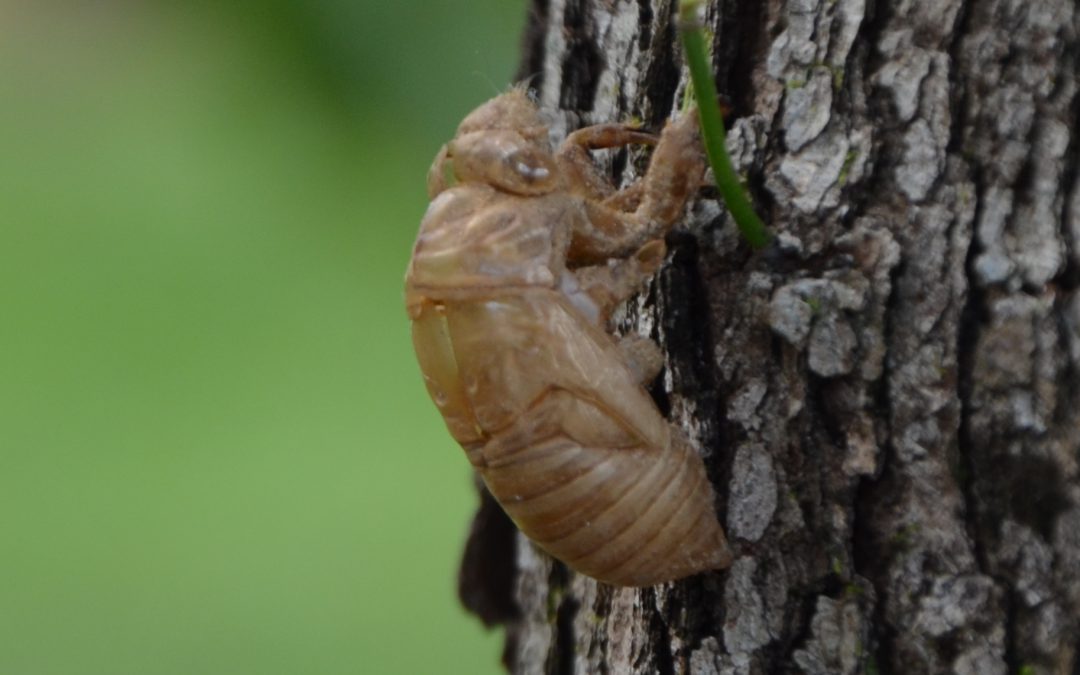
by Les Harrison | Oct 26, 2018
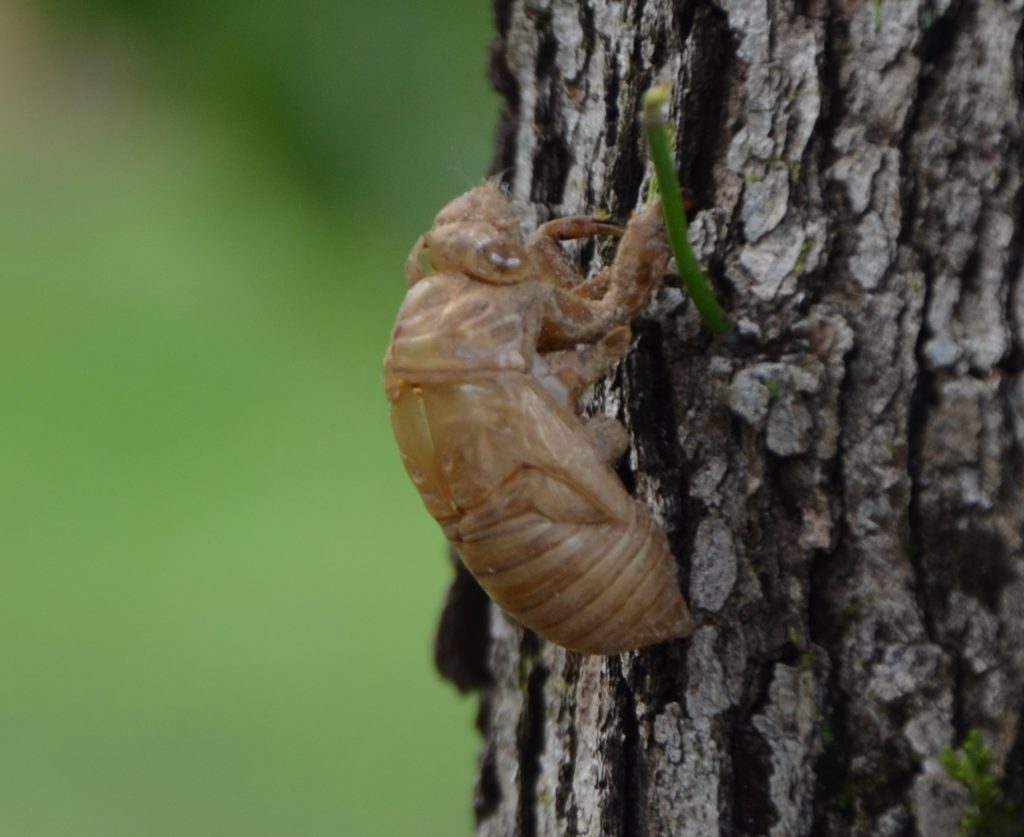
Only a shell of its former self, the exoskeleton shed by a cicada is all that remains of the previous night’s long pursuits.
Autumn evenings in the panhandle are usually beginning to reflect the official change of seasons with cooler air and a slight lessening of the raucous din created by insects and birds. The recent early-fall hurricanes have brought the area a wide breath of hot, humid air, delaying the long anticipated start of relief from the sultry summer environment.
Anyone hearty enough to take an early evening walk in north Florida will experience a continuation of the frenetic activity and riotous sounds typical to summer in the south. The near deafening call of cicadas (Magicicada spp.) is part of the cacophony.
Once commonly identified as locust in the region, their near-mechanical buzzing originates from the protection of foliage in trees and bushes during the day or twilight hours. During the dark hours they sing often and relocate frequently.
It is important to note cicadas are not the locust of infamy which shred the green, lush landscapes and foretells famine. While locust and cicadas are both insects, the similarities end there.
These seldom seen or captured insects known for their boisterous, sometimes undulating, chorus do leave strategically placed souvenirs for the sharp-eyed observer. This discarded residue of their early life stages is a highly valued tool for many elementary school boys with a prank in mind. The hard shell is harmless, but under the right conditions does have a certain shock value appreciated by juvenile miscreants.
Their nymph stage skeletons are often seen on the trunks of trees, shrubs stalks and even the siding of buildings. The opaque brown shells are abandoned when the cicada outgrows it and then emerges to form a new exterior.
The process is similar in other insect species with an exoskeleton having very limited potential for growth and expansion. The rigid coating provides this creature an armored surface to fend off the challenges of being small and small in a big hungry world.
In some states, cicadas are famous for their periodic appearance in colossal numbers, sometimes as many as 1.5 million per acre. These once every 13 to 17 year swarms do not occur in Florida which has an insect friendly environment.
The 19 Florida cicada species fall into three groups based on overall size measured by the length of the forewings. They produce their songs with timbals, paired drum-like structures on the sides of the abdominal segments.
A muscle attached to the timbal plate causes the timbal ribs to pop inward and project outward when relaxed. Flexed rapidly, the cicada chorus can deliver hours of uninterrupted night music.
In Florida, only males have timbals and the females are mute. Most sounds made by males are calling songs which serve to attract the silent females.
Cicada nymphs live in underground burrows where they feed on xylem sap from roots of grasses or woody plants. Because xylem sap is low in nutrients, complete nymph development takes several years to successfully mature.
All cicada species molt four times underground. When the cicada nymph is ready for its fifth and final molt it makes its way to the soil’s surface. It climbs a short distance up a tree trunk or stem, anchors itself and molts for the last time becoming an adult.
If male, the new cicada will add its contribution to the nightly festivities. If female, she will quietly wait for that special, one in a million, nocturnal crooner.
To learn more about north Florida’s noisy night insects, contact the local UF/IFAS County Extension Office. Click here for contact information.
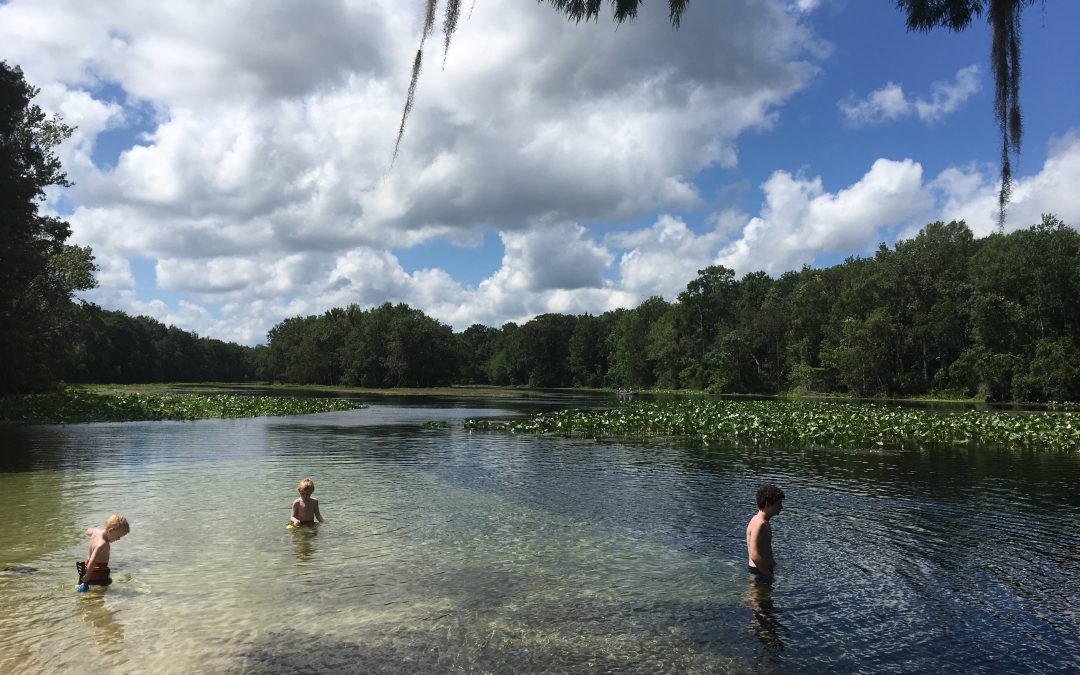
by Les Harrison | Sep 28, 2018
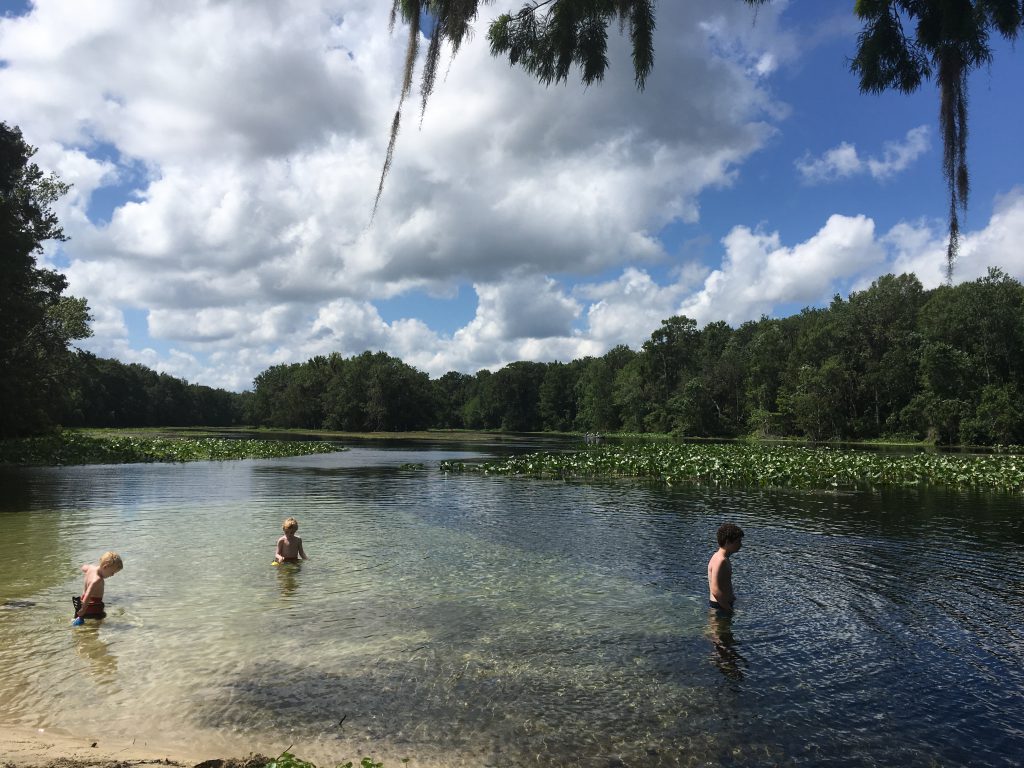
The Wacissa River offers paddlers the opportunity to see north Florida unfiltered.
Being off the beaten path has many advantages. In the case of a spring-fed river, it translates to less pressure from human use and a great opportunity for those who do visit to experience the “real Florida”.
The Wacissa River, located in the southern half of Jefferson County, Florida, is near the crossroads identified as the town of Wacissa. There is a blinking light, a post office, and two small convenience stores where beer, ice and snacks can be purchased.
Access to the river is about two miles south of the blinking light on Florida 59, just after the state road veers to the southwest. The blacktop spur quickly become a dirt parking lot after passing several canoe and kayak rental businesses.
A county maintained boat landing with pick-nic tables, a manmade beach, and a tiny diving platform with a rope swing are the only signs of civilization. The cold, clear water extends to a tree line several hundred yards south of the landing with the river moving to the southeast.
The river emerges crystal clear from multiple limestone springs along the first mile and a half of the 12 mile waterway. The adjacent land is flat and subject to being swampy, especially in wet years like 2018.
The river terrain stands in contrast to the Cody Scarp just a few miles to the north. This geologic feature is the remnants of an ancient marine terrace and is hilly, rising 100 feet above the river in some spots.
Cypress, oak, pine, and other trees cover the bottomlands adjacent to the river. The river quickly enters the Aucilla Wildlife Management Area which results in a wide variety of animals, birds, amphibians and reptiles.
The wildlife viewing varies by season. Many migratory birds use the river’s shelter and resources on their annual trips.
Canoeing and kayaking are popular in the gentle current. Powerboats and fan boats can use the area also, but must be on constant alert for shallow spots and hidden snags.
For the adventurous paddler who wants to follow the river’s course, there is a debarkation point at Goose Pasture Campgrounds and another near St. Marks after the Wacissa merges with the Aucilla.
Be prepared when taking this journey. This is the real Florida, no fast food restaurants or convenience stores. Only clear water, big trees and the calls of birds will be found here.
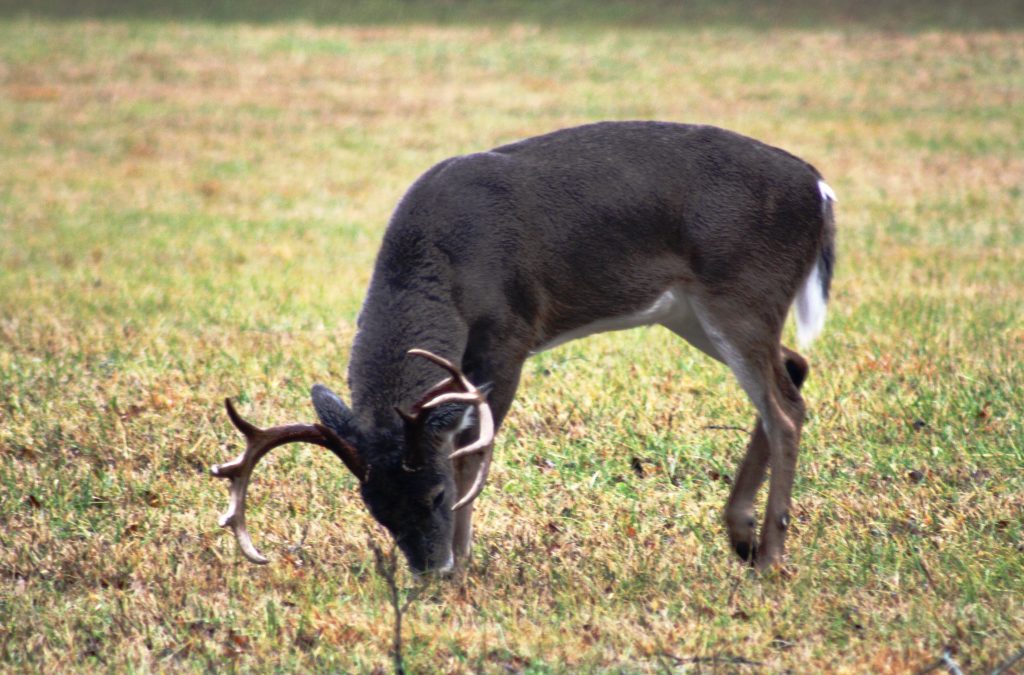
by Shep Eubanks | Sep 12, 2018
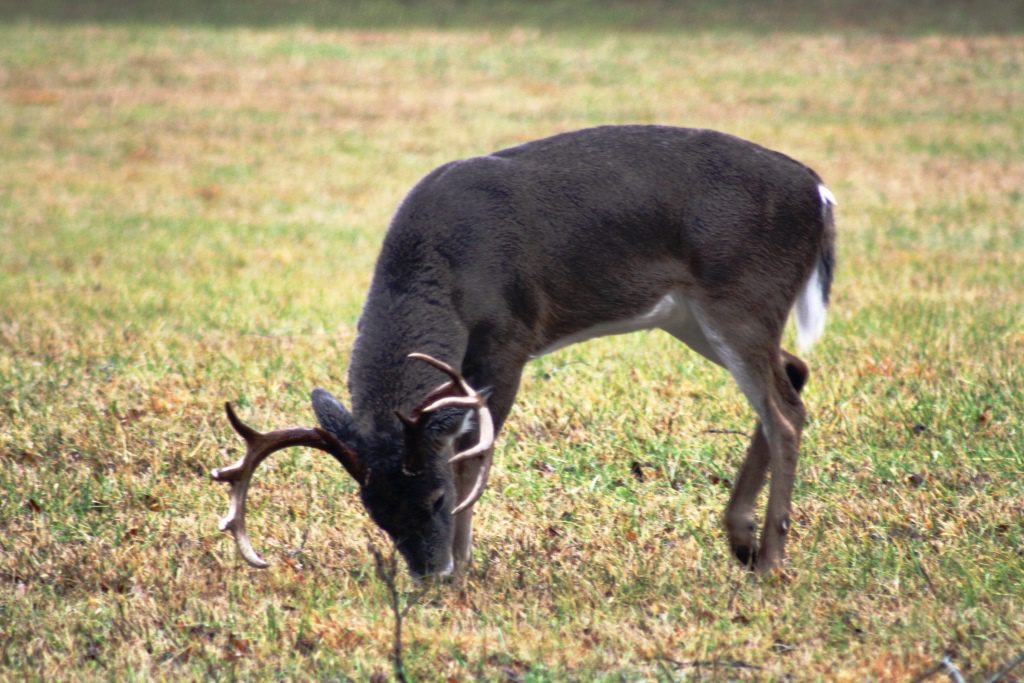
North Florida buck feeding on acorns at the edge of a food plot. Photo Credit – Shep Eubanks UF/IFAS
It’s that time of year when landowners, hunters, and other wildlife enthusiasts begin to plan and prepare fall and winter food plots to attract wildlife like the nice buck in the photo.
Annual food plots are expensive and labor intensive to plant every year and with that thought in mind, an option you may want to consider is planting mast producing crops around your property to improve your wildlife habitat. Mast producing species are of two types of species, “hard mast” (oaks, chestnut, hickory, chinkapin, American Beech, etc.), and “soft mast” (crabapple, persimmon, grape, apple, blackberry, pears, plums, pawpaws, etc.). There are many mast producing trees and shrubs that can be utilized and will provide food and cover for a variety of wildlife species. This article will focus on two, sawtooth oak (or other oaks) and southern crabapple.
Sawtooth Oak
Oaks are of tremendous importance to wildlife and there are dozens of species in the United States. In many areas acorns comprise 25 to 50% of a wild turkeys diet in the fall (see photos 1, 2, and 3) and probably 50% of the whitetail deer diet as well during fall and winter. White oak acorns average around 6% crude protein versus 4.5% to 5% in red oak acorns. These acorns are also around 50% carbohydrates and 4% fat for white oak and 6% fat for red oak.
The Sawtooth Oak is in the Red Oak family and typically produces acorns annually once they are mature. The acorns are comparable to white oak acorns in terms of deer preference as compared to many other red oak species. Most red oak acorns are high in tannins reducing palatability but this does not seem to hold true for sawtooth oak. They are a very quick maturing species and will normally begin bearing around 8 years of age. The acorn production at maturity is prolific as you can see in the photo and can reach over 1,000 pounds per tree in a good year when fully mature. They can reach a mature height of 50 to 70 feet. There are two varieties of sawtooth oak, the original sawtooth and the Gobbler sawtooth oak, which has a smaller acorn that is better suited for wild turkeys. The average lifespan of the sawtooth oak is about 50 years
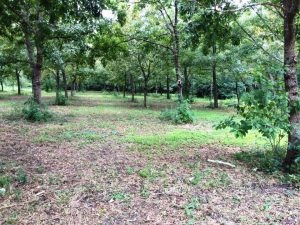
Photo 1 – Seventeen year old planting of sawtooth oaks in Gadsden County Florida. Photo Credit – Shep Eubanks UF/IFAS

Photo 2 – Gadsden County gobblers feeding on Gobbler sawtooth oak acorns
Photo Credit – Shep Eubanks UF/IFAS
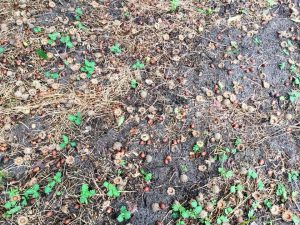
Photo 3 – Gobbler sawtooth oak acorns in Gadsden County. Notice the smaller size compared to the regular sawtooth oak acorn which is the size of a white oak acorn.
Photo credit – Shep Eubanks UF/IFAS
Southern Crabapple
Southern Crabapple is one of 25 species of the genus Malus that includes apples. They generally are well adapted to well drained but moist soils and medium to heavy soil types. They will grow best in a pH range of 5.5 – 6.5 and prefer full sun but will grow in partial shade as can be seen in photo 4. They are very easy to establish and produce beautiful blooms in March and April in our area as seen in photo 5. There are many other varieties of crabapples such as Dolgo that are available on the market in addition to southern and will probably work very well in north Florida. The fruit on southern crabapple is typically yellow green to green and average 1 to 1.5 inches in diameter. They are relished by deer and normally fall from the tree in early October.
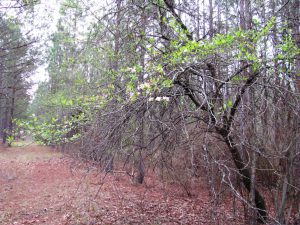
Photo 4 – Southern crabapple tree planted on edge of pine plantation stand. Photo taken in late March during bloom.
Photo credit – Shep Eubanks UF/IFAS
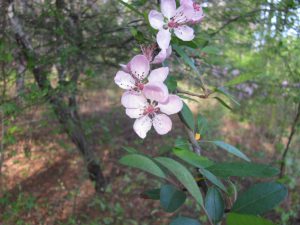
Photo 5 – Showy light pink to white bloom of southern crabapple in early April during bloom.
Photo credit – Shep Eubanks UF/IFAS
A good resource publication on general principles related o this topic is Establishing and Maintaining Wildlife Food Sources.
If you are interested in planting traditional fall food plots check out this excellent article by UF/IFAS Washingon Couny Extension Agent Mark Mauldin: Now’s the Time to Start Preparing for Cool-Season Food Plots .
For more information on getting started with food plots in your county contact your county’s UF/IFAS Extension Office
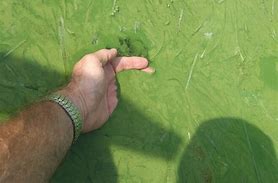
by Rick O'Connor | Aug 17, 2018
Being in the panhandle of Florida you may, or may not, have heard about the water quality issues hindering the southern part of the state. Water discharged from Lake Okeechobee is full of nutrients. These nutrients are coming from agriculture, unmaintained septic tanks, and developed landscaping – among other things. The discharges that head east lead to the Indian River Lagoon and other Intracoastal Waterways. Those heading west, head towards the estuaries of Sarasota Bay and Charlotte Harbor.

A large bloom of blue-green algae (cyanobacteria) in south Florida waters.
Photo: NOAA
Those heading east have created large algal blooms of blue-green algae (cyanobacteria). The blooms are so thick the water has become a slime green color and, in some locations, difficult to wade. Some of developed skin rashes from contacting this water. These algal blooms block needed sunlight for seagrasses, slow water movement, and in the evenings – decrease needed dissolved oxygen. When the algae die, they begin to decompose – thus lower the dissolved oxygen and triggering fish kills. It is a mess – both environmentally and economically.
On the west coast, there are red tides. These naturally occurring events happen most years in southwest Florida. They form offshore and vary in intensity from year to year. Some years beachcombers and fishermen barely notice them, other years it is difficult for people to walk the beaches. This year is one of the worst in recent memories. The increase in intensity is believed to be triggered by the increase in nutrient-filled waters being discharged towards their area.
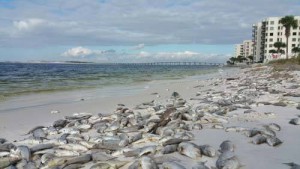
Dead fish line the beaches of Panama City during a red tide event in the past.
Photo: Randy Robinson
On both coasts, the economic impact has been huge and the quality of life for local residents has diminished. Many are pointing the finger at the federal government who, through the Army Corp of Engineers, controls flow in the lake. Others are pointing the finger at shortsighted state government, who have not done enough to provide a reserve to discharge this water, not enforced nutrient loads being discharged by those entities mentioned above. Either way, it is a big problem that has been coming for some time.
As bad as all of this is, how does this impact us here in the Florida panhandle?
Though we are not seeing the impacts central and south Florida are currently experiencing, we are not without our nutrient discharge issues. Most of Florida’s world-class springs are in our part of the state. In recent years, the water within these springs have seen an increase in nutrients. This clouds the water, changing the ecology of these systems and has already affected glass bottom boat tours at some of the classic springs. There has also been a decline in water entering the springs due to excessive withdrawals from neighboring communities. The increase in nutrients are generally from the same sources as those affecting south Florida.
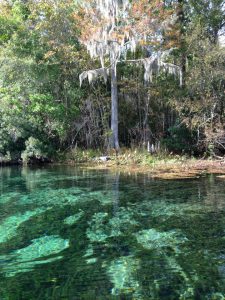
Florida’s springs are world famous. They attracted native Americans and settlers; as well as tourists and locals today.
Photo: Erik Lovestrand
Though we are not seeing large algal blooms in our local estuaries, there are some problems. St. Joe Bay has experienced some algal blooms, and a red tide event, in recent years that has forced the state to shorten the scallop season there – this obviously hurts the local economy. Due to stormwater runoff issues and septic tanks maintenance problems, health advisories are being issued due to high fecal bacteria loads in the water. Some locations in the Pensacola area have levels high enough that advisories must be issued 30% of the time they are sampled – some as often as 40%. Health advisories obviously keep tourists out of those waterways and hurt neighboring businesses as well as lower the quality of life for those living there.
Then of course, there is the Apalachicola River issue. Here, water that normally flows from Georgia into the river, and eventually to the bay, has been held back for water needs in Georgia. This has changed flow and salinity within the bay, which has altered the ecology of the system, and has negatively impacted one of the more successful seafood industries in the state. The entire community of Apalachicola has felt the impact from the decision to hold the water back. Though the impacts may not be as dramatic as those of our cousins in south Florida, we do have our problems.
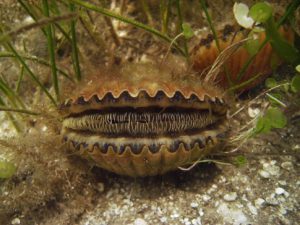
Bay Scallop Argopecten iradians
http://myfwc.com/fishing/saltwater/recreational/bay-scallops/
What can we do about it?
The quick answer is reduce our nutrient input.
The state has adopted Best Management Practices (BMPs) for farmers and ranchers to help them reduce their impact on ground water and surface water contamination from their lands. Many panhandle farmers and ranchers are already implementing these BMPs and others can. We encourage them to participate. Read more at Florida’s Rangeland Agriculture and the Environment: A Natural Partnership – https://nwdistrict.ifas.ufl.edu/nat/2015/07/18/floridas-rangeland-agriculture-and-the-environment-a-natural-partnership/.
As development continues to increase across the state, and in the panhandle, sewage infrastructure is having trouble keeping up. This forces developments to use septic tanks. Many of these septic systems are placed in low-lying areas or in soils where they should not be. Others still are not being maintained property. All of this leads to septic leaks and nutrients entering local waterways. We would encourage local communities to work with new developments to be on municipal sewer lines, and the conversion of septic to sewer in as many existing septic systems as possible. Read more at Maintaining Your Septic Tank – https://nwdistrict.ifas.ufl.edu/nat/2017/04/29/maintain-your-septic-system-to-save-money-and-reduce-water-pollution/.
And then there are the lawns. We all enjoy nice looking lawns. However, many of the landscaping plans include designs that encourage plants that need to be watered and fertilized frequently as well as elevations that encourage runoff from our properties. Following the BMPs of the Florida Friendly Landscaping ProgramTM can help reduce the impact your lawn has on the nutrient loads of neighboring waterways. Read more at Florida Friendly Yards – https://nwdistrict.ifas.ufl.edu/nat/2018/06/08/restoring-the-health-of-pensacola-bay-what-can-you-do-to-help-a-florida-friendly-yard/.
For those who have boats, there is the Clean Boater Program. This program gives advice on how boaters can reduce their impacts on local waterways. Read more at Clean Boater – https://floridadep.gov/fco/cva/content/clean-boater-program.
One last snippet, those who live along the waterways themselves. There is a living shoreline program. The idea is return your shoreline to a more natural state (similar to the concept of Florida Friendly LandscapingTM). Doing so will reduce erosion of your property, enhance local fisheries, as well as reduce the amount of nutrients reaching the waterways from surrounding land. Installing a living shoreline will take some help from your local extension office. The state actually owns the land below the mean high tide line and, thus, you will need permission (a permit) to do so. Like the principals of a Florida Friendly Yard, there are specific plants you should use and they should be planted in a specific zone. Again, your county extension office can help with this. Read more at The Benefits of a Living Shoreline – https://nwdistrict.ifas.ufl.edu/nat/2017/10/06/the-benefits-of-a-living-shoreline/.
Though we may not be experiencing the dramatic problems that our friends in south Florida are currently experiencing, we do have our own problems here in the panhandle – and there is plenty we can do to keep the problems from getting worse. Please consider some of them. You can always contact your local county extension office for more information.
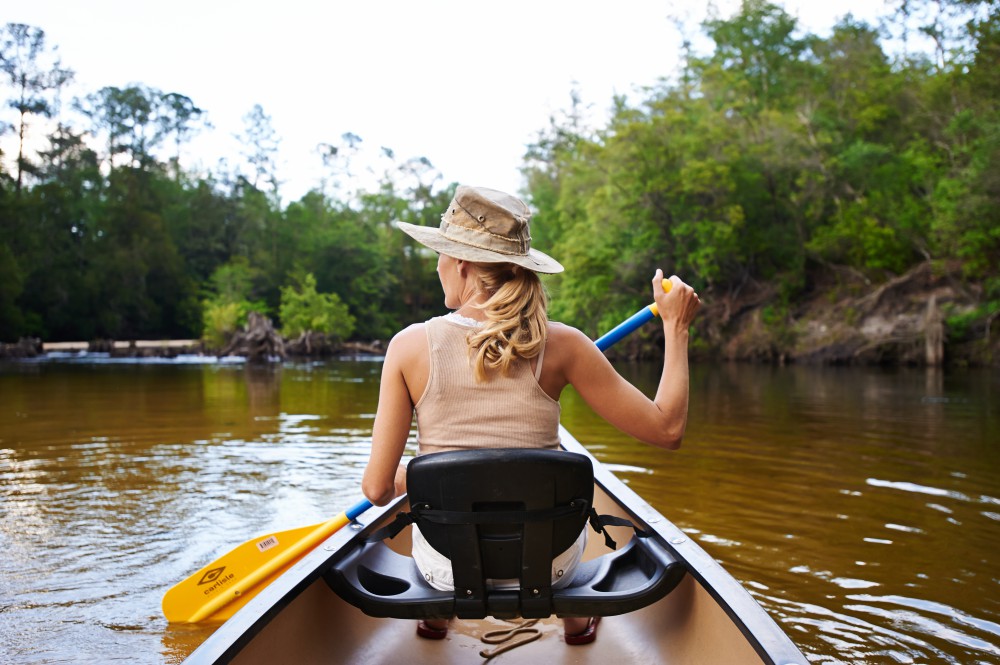
by Carrie Stevenson | Jul 23, 2018

Local estuaries are a beautiful place to explore with your family. Credit: Matthew Deitch, UF IFAS Extension
Florida’s rivers, springs, wetlands, and estuaries are central features to the identity of northwest Florida. They provide a wide range of services that benefit peoples’ health and well-being in our region. They create recreational opportunities for swimmers, canoers, and kayakers; support diverse wildlife for birders and plant enthusiasts; sustain a vibrant commercial and recreational fishery and shellfishery; serve as corridors for shipping and transportation; and support ecosystems that help to improve water quality. Maintaining these aquatic ecosystem services requires a low level of chemical inputs from the upstream areas that comprise their watersheds.
Aquatic ecosystems are especially sensitive to nitrogen and phosphorus, which are key nutrients for the growth of plants, algae, and bacteria that live in these waters. High levels of these nutrients combined with our sunny weather and warm summer temperatures create conditions that can lead to rapid growth of aquatic plants and algae, which can cover these water bodies and make them no longer enjoyable for people and wildlife. It can also cause dissolved oxygen levels to fall, as plants respire (especially at night, when they are not photosynthesizing) and as bacteria consume oxygen to break down dead plant material. Low dissolved oxygen can create conditions that are deadly for fish and shellfish.
The Florida Department of Environmental Protection (FDEP) lists more than 1,400 water bodies (including rivers, springs, wetlands, and estuaries) as impaired by pollutants. Many of these are impaired by excessive nitrogen or phosphorus. It is a daunting challenge to reduce pollutants in these water bodies because their inputs frequently come from all over the landscape, rather than a specific point—nutrients can come from agricultural fields, residential landscapes, septic tanks, atmospheric deposition, and livestock throughout the watershed.
In Florida, FDEP has begun a program to reduce nutrient concentrations in impaired watersheds by collaborating with landowners and other stakeholders to develop management programs to reduce pollutants entering the state’s waters. This pollutant reduction program is currently focused on Florida’s spring systems, including Jackson Blue Spring and Merritt’s Mill Pond in Jackson County. Merritt’s Mill Pond is a 4-mile long, 270-acre pond located near Marianna, and it is a popular regional destination for swimming, boating, kayaking, and fishing in the Panhandle. Its main source is Jackson Blue Spring, which produces, on average, more than 70 million gallons of water each day. Excessive growth of aquatic plants and algae in the pond during summer reduces the area available for swimming and boating. In 2014, FDEP began working with agricultural producers, residents, developers, local government officials, and other stakeholders to identify nutrient contributions in the Merritt’s Mill Pond watershed and develop an action plan to reduce nutrients entering the pond in the coming decades. Collaborations with stakeholders help to improve the accuracy of pollutant estimates, and to ensure the plan is designed appropriately to achieve desired ecological outcomes.
This Action Plan for reducing nutrients into Merritt’s Mill Pond provides an opportunity for land managers to implement their own plans to reduce nutrient contributions without FDEP imposing rigid regulations or mandating particular actions. People can choose from an array of Best Management Practices designed to reduce nutrient contributions, and the state has made funds available for people to help implement these plans. Implementing this Action Plan will restore the wonders of Merritt’s Mill through the 21st Century.
This article was written by: Matthew J Deitch, PhD, Assistant Professor, Watershed Management with the UF IFAS Soil and Water Sciences Department at the West Florida Research and Education Center. For more information, you can contact him at mdeitch@ufl.edu or 850-377-2592.
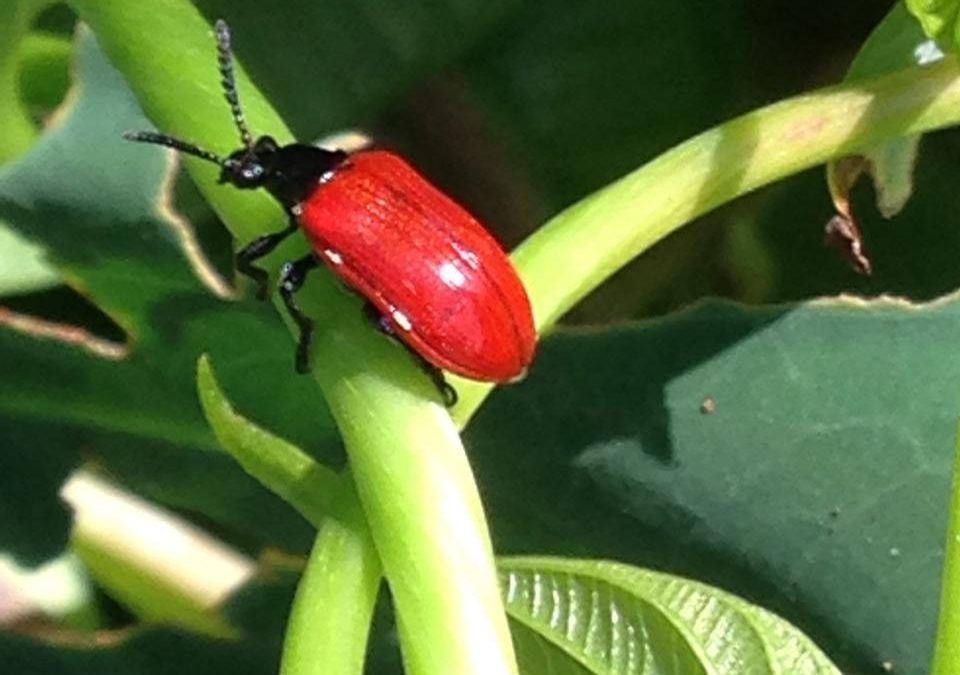
by Scott Jackson | May 25, 2018
By L. Scott Jackson and Julie B. McConnell, UF/IFAS Extension Bay County
Northwest Florida’s pristine natural world is being threaten by a group of non-native plants and animals known collectively as invasive species. Exotic invasive species originate from other continents and have adverse impacts on our native habitats and species. Many of these problem non-natives have nothing to keep them in check since there’s nothing that eats or preys on them in their “new world”. One of the most problematic and widespread invasive plants we have in our local area is air potato vine.
Air potato vine originated in Asia and Africa. It was brought to Florida in the early 1900s. People moved this plant with them using it for food and traditional medicine. However, raw forms of air potato are toxic and consumption is not recommended. This quick growing vine reproduces from tubers or “potatoes”. The potato drops from the vine and grows into the soil to start new vines. Air potato is especially a problem in disturbed areas like utility easements, which can provide easy entry into forests. Significant tree damage can occur in areas with heavy air potato infestation because vines can entirely cover large trees. Some sources report vine growth rates up to eight inches per day!
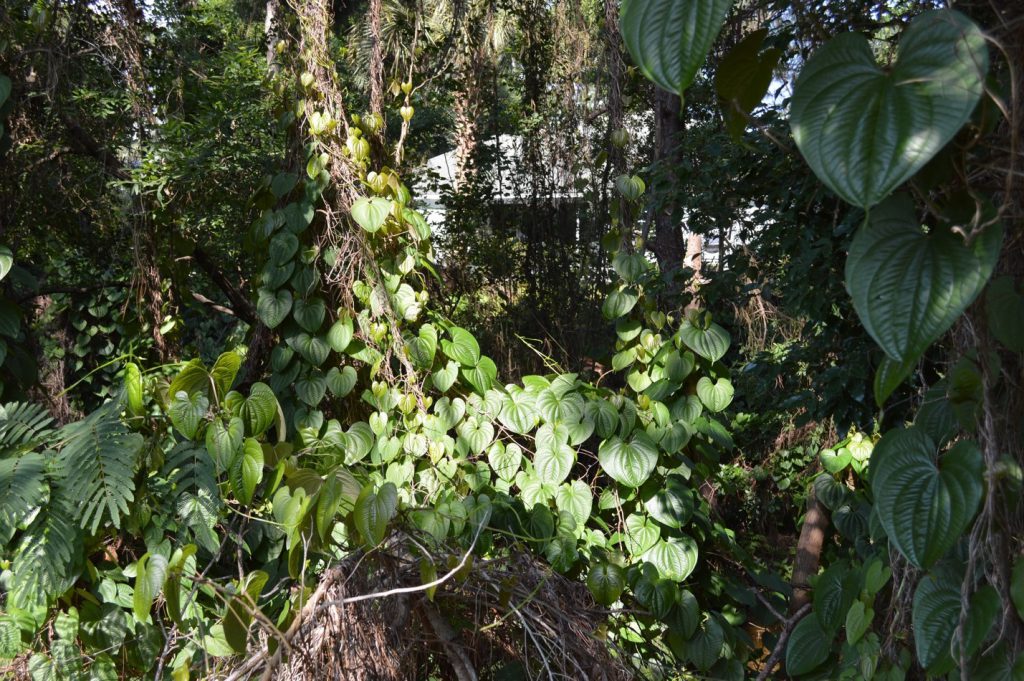
Air Potato vines covering native shrubs and trees in Bay County, Florida. (Photo by L. Scott Jackson)
Mechanical removal of vines and potatoes from the soil is one control method. Additionally, herbicides are often used to remediate areas dominated by air potato vine but this runs the risk of affecting non-target plants underneath the vine. A new tool for control was introduced to Florida in 2011, the air potato leaf beetle. Air potato beetle releases have been monitored and evaluated by United States Department of Agriculture (USDA) researchers and scientists for several years.

Air Potato Beetle crawling on leaf stem. Beetles eat leaves curtailing the growth and impact of air potato. (Photo by Julie B. McConnell)
Air potato beetles target only air potato leaves making them a perfect candidate for biological control. Biological controls aid in the management of target invasive species. Complete eradication is not expected, however suppression and reduced spread of air potato vine is realistic.
UF/IFAS Extension Bay County will host the Air Potato Challenge on June 6, 2018. Citizen scientist will receive air potato beetles and training regarding introduction of beetles into their private property infested with air potato vine. Pre-registration is recommended to receive the air potato beetles. Please visit http://bit.ly/bayairpotato
In conjunction with the Air Potato Challenge, UF/IFAS Extension Bay County will be hosting an invasive species awareness workshop. Dr. Steve Johnson, UF/IFAS Associate Professor of Wildlife Ecology, will be presenting “Exotic Invaders: Reptiles and Amphibians of Concern in Northwest Florida”. Additionally, experts from UF/IFAS Extension, Florida Fish and Wildlife, and the Science and Discovery center will have live exhibits featuring invasive reptiles, lionfish, and plants. For more information visit http://bay.ifas.ufl.edu or call the UF/IFAS Extension Bay County Office at 850-784-6105.
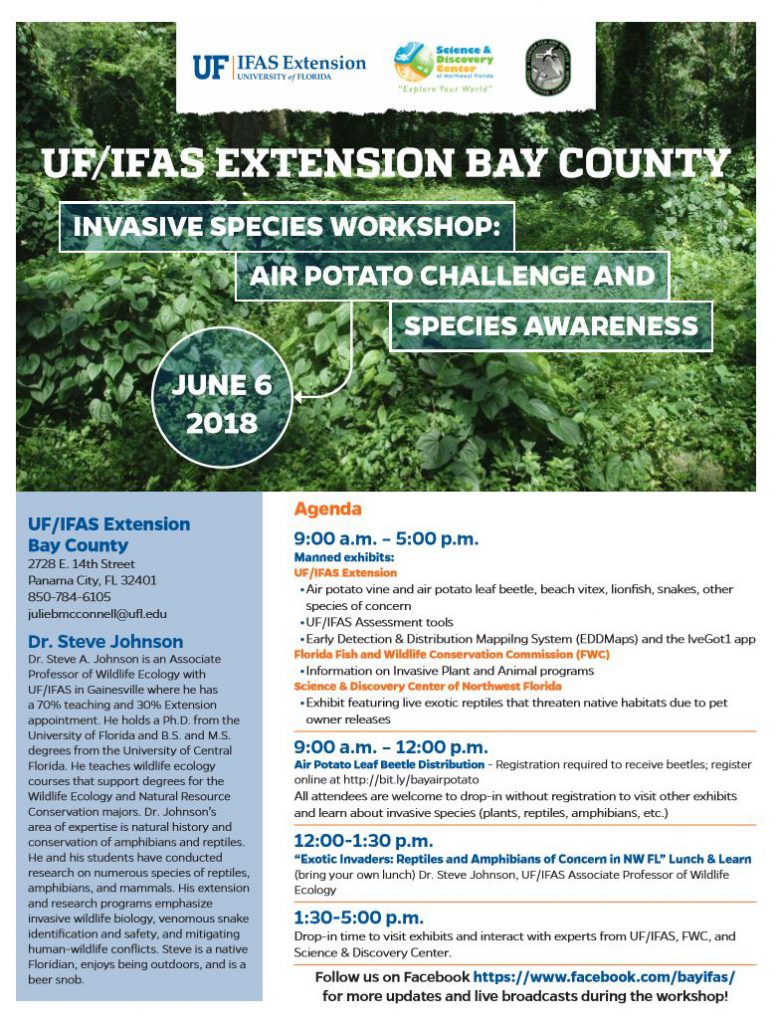
Flyer for Air Potato Challenge and Invasive Species Workshop June 6 2018





















